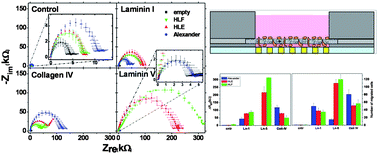Automatic transwell assay by an EIS cell chip to monitor cell migration†
Abstract
Here an EIS (

* Corresponding authors
a
NNL CNR-Istituto Nanoscienze, Via per Arnesano, Lecce, Italy
E-mail:
elisabetta.primiceri@unisalento.it, giuseppe.maruccio@unisalento.it
b Scuola Superiore ISUFI, Univ. of Salento, Via per Arnesano, Lecce, Italy
c Dept. of Innovation Engineering, University of Salento, Via per Arnesano, Lecce, Italy
d Department of Internal Medicine, Immunology, and Infectious Diseases, Section of Internal Medicine, University of Bari Medical School, Bari, Italy
e Dept. of Physics, University of Salento, Via per Arnesano, Lecce, Italy
Here an EIS (

 Please wait while we load your content...
Something went wrong. Try again?
Please wait while we load your content...
Something went wrong. Try again?
E. Primiceri, M. S. Chiriacò, F. Dioguardi, A. G. Monteduro, E. D'Amone, R. Rinaldi, G. Giannelli and G. Maruccio, Lab Chip, 2011, 11, 4081 DOI: 10.1039/C1LC20540D
To request permission to reproduce material from this article, please go to the Copyright Clearance Center request page.
If you are an author contributing to an RSC publication, you do not need to request permission provided correct acknowledgement is given.
If you are the author of this article, you do not need to request permission to reproduce figures and diagrams provided correct acknowledgement is given. If you want to reproduce the whole article in a third-party publication (excluding your thesis/dissertation for which permission is not required) please go to the Copyright Clearance Center request page.
Read more about how to correctly acknowledge RSC content.
 Fetching data from CrossRef.
Fetching data from CrossRef.
This may take some time to load.
Loading related content
